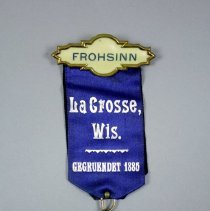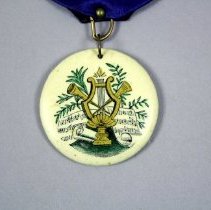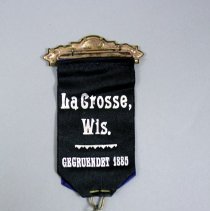Object Record
Images



Metadata
Object Name |
Badge, Membership |
Catalog Number |
2017.fic.1066 |
Description |
Badge from Frohsinn Singing Society. Pin portion is metal with white plastic inlay and text "FROHSINN" stamped in blue. The front of the ribbon is blue with silver text "La Crosse, Wis. Gegruendet 1885". There is a medallion attached below with a picture of a harp, trumpets, sheets of mustic, and olive branches on the front. The back of the ribbon is black and contains the same silver text as the front. The back of the medallion has black text "In Memoriam" and is surrounded by black branches. |
Provenance |
Badge from Frohsinn Singing Society of La Crosse WI. They were a German singing group that went to concerts and festivals in the Midwest. |
Dimensions |
W-2.25 L-4.75 inches |
Length (in) |
4.750 |
Width (in) |
2.250 |
Subjects |
Organizations & Clubs Music Cultures "Things that Matter" |
Search Terms |
Frohsinn "Things that Matter" |
Relation |
Show Related Records... |
Notes |
The reverse of the badge (the black side) would have been worn at funerals. Featured in Things that Matter "This colorful badge once decorated the lapel of a member of Frohsinn, La Crosse’s German singing society. The badge’s attached disk, with classical style lyre, highlighted a love of music, while the top of the badge and blue ribbon proudly stated, "Frohsinn, La Crosse, Wis., Gegrundt (Founded) 1885." The one-time local owner is unknown, as is the badge’s age. Similar be-ribboned badges were used by fraternal and union organizations in the late 19th and early 20th century. This one probably dates from about 1900. The Frohsinn badge is reversible. Its front ribbon is blue, but there’s a second black ribbon on the back. The attached disk reads "In Memoriam (in memory of)," making it suitable for funerals. The Frohsinn Society (froh Sinn means happy state of mind in German) began as a literary society and current affairs forum, but it soon evolved into a singing group that celebrated German heritage. Activities often centered around Germania Hall on Fifth Avenue, between Market and Ferry streets. The building housed athletic, dramatic, educational and cultural groups, and once was the focus for German culture in La Crosse. Initially all Frohsinn members were men, though women joined in later years. The group participated in concerts and annual regional singing festivals throughout the Midwest. La Crosse hosted many such events, including the 1908 Saengerfest, with some 3,000 singers and 5,000 visitors. An auditorium was quickly constructed at Fourth and Jay Streets to accommodate the huge gathering. During World War I (1914-1918), anti-German sentiment caused a temporary lapse in participation in Frohsinn, but the organization regained strength and continued after the war. American folk and patriotic songs joined traditional German songs in its repertoire. As German immigrants in the area declined, so did Frohsinn. The last Saengerfest was held here in 1959. After that, the organization dwindled. Later, Oktoberfest came to be seen as the primary expression of German heritage in La Crosse. The Frohsinn Singing Society badge represents a time when area Germans enjoyed expressing their heritage through choral singing. The group offered support and community to immigrants, reminding them of the country left behind and helping them adjust to their new life here." This article was originally published in the La Crosse Tribune. Title: Frohsinn Singing Society badge Author: Carol Mullen Publish Date: July 15, 2017 |